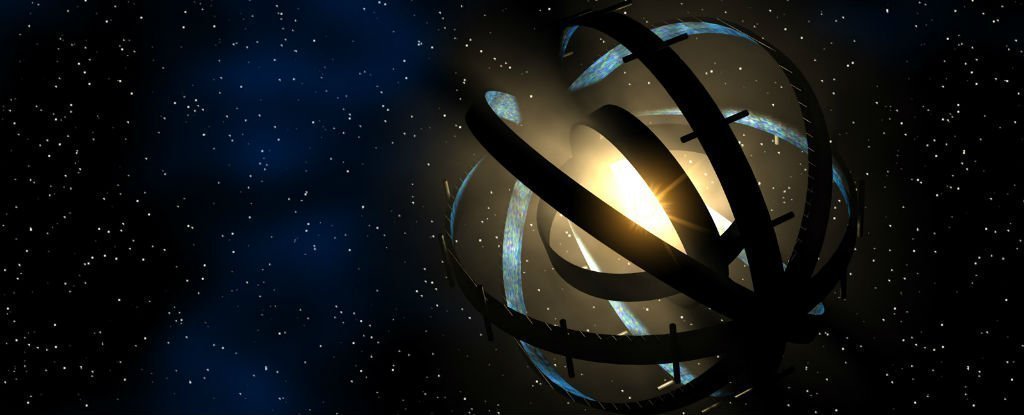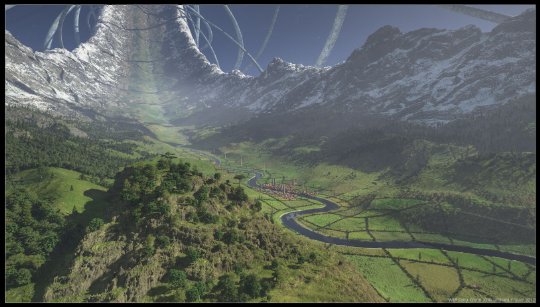Where do we rank on the Kardeshev scale?
The Kardeshev scale was invented by the astronomer Nicholai Kardeshev in 1964. The Kardeshev scale was originally intended to rank how advanced a civilization is based on only how much energy such a civilization consumed for satellite communication, but since then the scale has been modified to measure how advanced a technological civilization is based on their total energy usage (or power usage to be technically correct). In this modified Kardeshev scale, a technological civilization is ranked as either a Type I civilization, a Type II civilization, or a Type III civilization. A Type I civilization is one which utilizes an amount of energy on the order of the amount of power the Earth gets from the Sun, which is \(~10^{16}W\); a Type II civilization is one which utilizes an amount of power of \(~10^{26}W\) by building a megastructure (i.e. a Dyson swarm) around their home star to harvest its energy; and a type III civilization is one which utilizes the power output of their entire galaxy by building megastructures around every star in their galaxy.
This video was produced by krishnal1y.
Human civilization today uses only about \(1.2×10^{13}W\) of power and thus doesn't even rank on the Kardeshev scale. As Michio Kaku once said, we are a "Type 0 civilization." But Carl Sagan once argued that there should be more than just three rank; he proposed using numbers with decimals to rank civilizations. According to Sagan, the scale should start at Type 0 which is associated with civilizations that use \(10^6W\) of power; the next rank on Sagan's modified Kardeshev scale is a Type 0.1 civilization which uses one more order of magnitude of power (that is, \(10^7W\) than a Type 0; a Type 0.2 uses another additional order of magnitude (that is, their power consumption is \(10^8W\); and so on. Carl Sagan estimated that humanity, as of 1973, ranked as a Type 0.7 civilization. In 2015, our total power consumption was \(17.35TW\) and we would have had ranked as a Type 0.7239 civilization on Sagan's modified Kardeshev scale. As Michio Kaku once said, in order for us to transition to a Type I civilization (also called a planetary civilization) and consume \(~10^{16}W\) of power, we'll need to harness all of Earth's solar, wind, tidal, hydroelectric, and geothermal energy. But we'll also need to construct in Earth-orbit massive arrays of solar panels which collect extra-solar energy. (Solar energy in space near the Earth consists of eight times more power than solar energy at the Earth's surface.) These satellites would beam back energy to Earth in the form of ultra-powerful microwaves. According to Michio Kaku, a Type I civilization would be able to control the natural forces of their planet including weather, hurricanes, volcanoes, and tornadoes. They would be masters of their planet.
As Carl Sagan once argued in his book, Pale Blue Dot, such a civilization, if it did not destroy itself, would innevitabely spread outwards and gradually, over the centuries, colonize the plants, moons, asteroid belts, and their solar system's equivalent of the Oort cloud.\(^1\) As they colonized and terraformed many of the worlds in their solar system, they would gradually move up the Kardeshev scale.
The Kardeshev scale ranks how advanced a technological civilization is based upon their total power consumption. A Type I civilization is capable of harnessing all of their home plant's power of \(~10^{16}W\); a Type II civilization has harnessed the power of their star ( \(~10^{26}W\)); and a Type III civilization has harnessed the power output of their entire galaxy ( \(~10^{36}W\)). There are even Type IV and Type V civilization which go beyond Kardeshev's original scale.
Type II civilizations
Due to the invention of potentially world-destroying contrivances such as nuclear fission and fusion technology, such a civilization would have had to long overcome scarcity, superstition and inequality—the number one determinants of war. For any technologically advanced society with nuclear technology, sectarianism and wars (caused primarily by scarcity, superstition and inequality) would eventually lead to a nuclear war (or an environmental catastrophe) which would lead to the demise of the species. Not only would their understanding of the universe have to be based on rational thought and empiricism to design and build their technology, but so to would their understanding of social and economic phenomena in order to build a sustainable society and environmentally sustainable infrastructure. The goal of such a society would be to minimize waste such as the enormous landfills of wasted metals and plastics (that we see in present human civilization) which could be used for far more useful purposes such as harvesting energy and building new infrastructure. But this same general principle of conservation would apply not just to the Earth but also to the solar system and beyond for advanced spacefairing civilizations who have colonized much of their solar system. Only the tiniest fraction of a star's solar energy is used to power biospheres living on the worlds in a solar system (if there is any life); the rest is essentially wasted as it disperses across the vast distances of space, never getting used. It would be far more useful if that energy were, instead, used to power artificial human habitats (such as O'Neil cylinders) circling around the Sun. After a Type I civilization has settled much of their solar system, they will begin dismantling the worlds and even parts of their home star and use all of those materials to begin constructing what is known as a Dyson swarm around their home star. A Dyson swarm is a hypothetical megastructure consisting of a vast number of satellites that orbit around a star and harvest its solar energy. The concept of a Dyson sphere (a Dyson swarm is a variation of this concept) was first proposed in a paper written by the physicist Freeman Dyson in 1960. A Dyson sphere is a hypothetical solid shell-like megastructure which encloses an entire star and absorbs 100% of its solar energy. Freeman Dyson predicted that humanity will eventually construct a Dyson sphere around the Sun within a few more thousand years. In reality, we would have to construct a different kind of megastructure (such as a Dyson swarm or ring world) around the Sun so that solar energy can reach the biospheres on Earth and likely Mars as well. This is how humanity will eventually transition to a Type II civilization (also called a stellar civilization)—a civilization whose total power consumption is on the order of \(~10^{26}W\) which is close the power output of the Sun.
Michio Kaku described our transition from a Type 0 civilization (or, to be technically correct, a Type 0.72 civilization) to a Type I civilization as the most important transition and time period in the history of humanity since such a transition would represent the triumph of science and humanitarianism over superstition and war. But the transition from a Type I to a Type II civilization would also be an epochal period in the history of the human race. There are so many ambitious projects today which seem daunting because of our lack of accessible energy. One of these is building ships capable of reaching the stars. As Dr. Robert Zubrin described in his book Entering Space, the enormous energy requirements of reaching Alpha Centuari (the nearest star system to our own) makes interstellar travel currently highly impractical at best. But with a Dyson swarm surrounding the Sun, we would have more than enough energy at our disposal to power stations of ultra-powerful lasers which, in turn, could power a fleet of solar sail nanoships to Alpha Centuari.
The amount of energy and materials available to a civilization still transitioning from Type I to Type II status would be sufficient to send fleets of millions of generational starships to the stars. It is likely that by time such a civilization transitioned to a K2 civilization (another name for a Type II civilization), they will have colonized thousands of other solar systems. They would begin constructing megastructures that only partially collect a star's solar energy (i.e. Dyson swarms) in any star systems which had life; for other star systems that had no life, they would begin building megastructures that collected all of the star's solar energy.
Type III civilizations
"Based on our current growth in energy usage, how long will it take before we use up all the energy of our planet, of our star, or even all the energy in our galaxy?" Video produced by Fraser Cain.
Long before reaching Type II status (and possibly even before reaching Type I status), advanced technological civilizations would have sent fleets of millions of self-replicating, solar sail nanoships to other star systems. Some of these nanoships will not survive their long interstellar voyage; but the remaining star ships might possibly land on a moon (or some other small world) in that distant star system. They could excavate the indigenous resources on such a world to 3D print factories. These factories would manufacture millions of more such solar sail, Von Nueman probes which would go on to reach other worlds in other star systems, 3D-printing more factories and allowing the cycle to continue. Assuming that such probes traveled in between \(10%\) light speed and arbitrarily close to light speed, those probes would eventually settle all four-hundred or so billion star systems in the Milky Way galaxy within \(100,000\) to one million years. Once scaling the Milky Way, humanity would then go on to construct megastructures around every star in the Milky Way galaxy until, eventually, we transitioned to a Type III civilization—a civilization capable of harnessing the entire energy output of their galaxy.
Type IV and V civilizations
Artist's depiction of the multi-verse.
When Nicholai Kardeshev initially propsed his scale, he did not think it was necessary to specify anything beyond a Type III civilization. But since then, other scientists have expanded the scale to include Type IV and Type V civilizations. After a civilization reaches Type III status harnessing not just the energy of all the stars in their home-galaxy but also the energy generated by the supermassive blackhole at the heart of their galaxy, they will ultimately go on to colonize other galaxies. After the passage of about one hundred thousand to one million years, even the galaxies beyond their observable universe could be colonized if, by then, they have developed faster-than-light (FTL) spaceships capable of reaching those distant galaxies which, due to the expansion of the universe, would be receding away from them faster than the speed of light. Eventually, after many eons, they might settle all of the galaxies in their universe and transition to a Type IV civilization—a civilization which harnesses all of the energy from all of the galaxies within their universe.
According to the many-worlds interpretation of quantum mechanics, we live in a sea of \(10^{500}\) other universes. And, according to Kip Thorne's work studying the solutions to the Einstein field equations, it is theoretically possible (according to the known laws of physics) to construct a rotating black hole which is connected by a traversable wormhole (that is, a wormhole you could travel through) to a black hole in other universes. These wormholes are like "highways through hyperspace" which K4 civilizations can traverse to reach other universes. Perhaps, such a civilization would go on to colonize all of the \(10^{500}\) other universes in the multiverse and transition to a Type V civilization—a civilization which harnesses all of the energy in the multi-verse. It is difficult to imagine such beings. They would be like gods which, according to Michio Kaku, could birth other universes.
This article is licensed under a CC BY-NC-SA 4.0 license.
Notes
1. Our solar system is surrounded and encompassed by an enormous sphere (with a radius of about one light-year) of trillions of icy comets. It is now believed that many other solar systems contain their own version of the Oort cloud.






